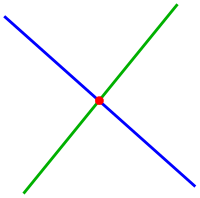
Back تقاطع (هندسة وصفية) Arabic Intersecció (geometria) Catalan Průsečík Czech Schnittpunkt German Intersección (geometría) Spanish تقاطع (هندسه) Persian Leikkauspiste Finnish Intersection (géométrie) French חיתוך (גאומטריה) HE Interseko (geometrio) IO

In geometry, an intersection is a point, line, or curve common to two or more objects (such as lines, curves, planes, and surfaces). The simplest case in Euclidean geometry is the line–line intersection between two distinct lines, which either is one point (sometimes called a vertex) or does not exist (if the lines are parallel). Other types of geometric intersection include:
- Line–plane intersection
- Line–sphere intersection
- Intersection of a polyhedron with a line
- Line segment intersection
- Intersection curve
Determination of the intersection of flats – linear geometric objects embedded in a higher-dimensional space – is a simple task of linear algebra, namely the solution of a system of linear equations. In general the determination of an intersection leads to non-linear equations, which can be solved numerically, for example using Newton iteration. Intersection problems between a line and a conic section (circle, ellipse, parabola, etc.) or a quadric (sphere, cylinder, hyperboloid, etc.) lead to quadratic equations that can be easily solved. Intersections between quadrics lead to quartic equations that can be solved algebraically.
© MMXXIII Rich X Search. We shall prevail. All rights reserved. Rich X Search